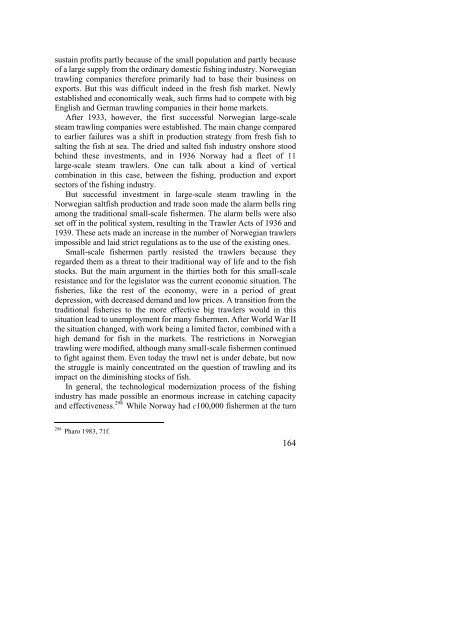The North Atlantic Fisheries, 1100-1976 - University of Hull
The North Atlantic Fisheries, 1100-1976 - University of Hull
The North Atlantic Fisheries, 1100-1976 - University of Hull
You also want an ePaper? Increase the reach of your titles
YUMPU automatically turns print PDFs into web optimized ePapers that Google loves.
sustain pr<strong>of</strong>its partly because <strong>of</strong> the small population and partly because<br />
<strong>of</strong> a large supply from the ordinary domestic fishing industry. Norwegian<br />
trawling companies therefore primarily had to base their business on<br />
exports. But this was difficult indeed in the fresh fish market. Newly<br />
established and economically weak, such firms had to compete with big<br />
English and German trawling companies in their home markets.<br />
After 1933, however, the first successful Norwegian large-scale<br />
steam trawling companies were established. <strong>The</strong> main change compared<br />
to earlier failures was a shift in production strategy from fresh fish to<br />
salting the fish at sea. <strong>The</strong> dried and salted fish industry onshore stood<br />
behind these investments, and in 1936 Norway had a fleet <strong>of</strong> 11<br />
large-scale steam trawlers. One can talk about a kind <strong>of</strong> vertical<br />
combination in this case, between the fishing, production and export<br />
sectors <strong>of</strong> the fishing industry.<br />
But successful investment in large-scale steam trawling in the<br />
Norwegian saltfish production and trade soon made the alarm bells ring<br />
among the traditional small-scale fishermen. <strong>The</strong> alarm bells were also<br />
set <strong>of</strong>f in the political system, resulting in the Trawler Acts <strong>of</strong> 1936 and<br />
1939. <strong>The</strong>se acts made an increase in the number <strong>of</strong> Norwegian trawlers<br />
impossible and laid strict regulations as to the use <strong>of</strong> the existing ones.<br />
Small-scale fishermen partly resisted the trawlers because they<br />
regarded them as a threat to their traditional way <strong>of</strong> life and to the fish<br />
stocks. But the main argument in the thirties both for this small-scale<br />
resistance and for the legislator was the current economic situation. <strong>The</strong><br />
fisheries, like the rest <strong>of</strong> the economy, were in a period <strong>of</strong> great<br />
depression, with decreased demand and low prices. A transition from the<br />
traditional fisheries to the more effective big trawlers would in this<br />
situation lead to unemployment for many fishermen. After World War II<br />
the situation changed, with work being a limited factor, combined with a<br />
high demand for fish in the markets. <strong>The</strong> restrictions in Norwegian<br />
trawling were modified, although many small-scale fishermen continued<br />
to fight against them. Even today the trawl net is under debate, but now<br />
the struggle is mainly concentrated on the question <strong>of</strong> trawling and its<br />
impact on the diminishing stocks <strong>of</strong> fish.<br />
In general, the technological modernization process <strong>of</strong> the fishing<br />
industry has made possible an enormous increase in catching capacity<br />
and effectiveness. 298 While Norway had c100,000 fishermen at the turn<br />
298 Pharo 1983, 71f.<br />
164















